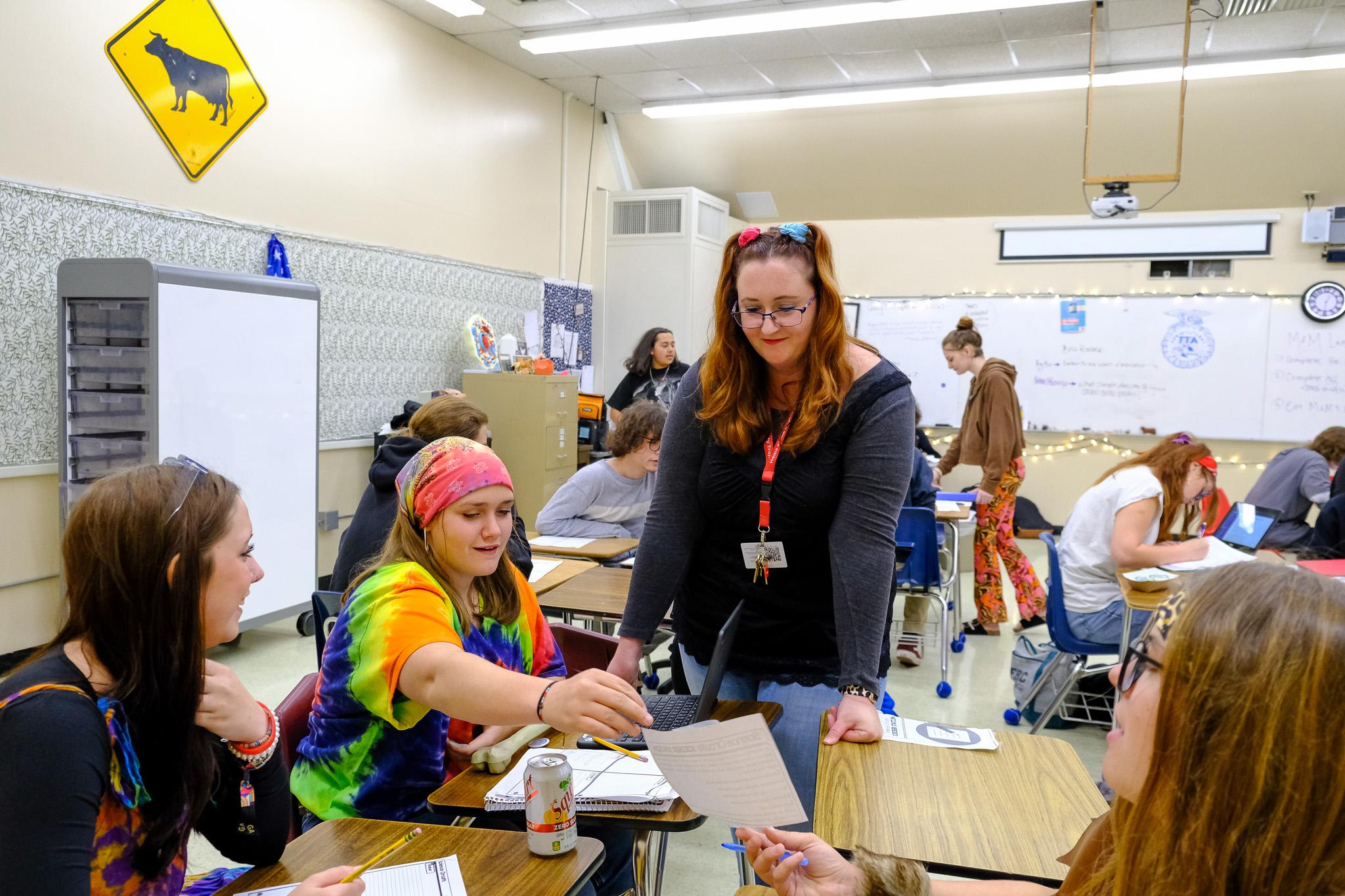QJSHS Ag Mechanics teacher Mr. Adam Wolosz, right, discusses the best method of sanding smooth the details of a student Nathan Rice’s project.
It’s a warm fall afternoon at Quincy Jr/Sr High School (QJSHS) and the wood shop is buzzing with the sound of saws and sanders. Students in Mr. Wolosz’s Agriculture Mechanics class are building small wooden boxes decorated with cut out jack-o-lantern faces, designed to show the glow of an LED candle or lantern placed inside. Although the shop is busy, the mood is calm, as Mr. Wolosz patiently assisted students one by one. Along with woodworking, the course will include modules on metal shop, electronics, and small engine repair.
In the classroom next door, Ms. Wrenn’s Sustainable Agricultural Biology students are starting a unit on Ecology, working in groups to complete a series of introductory research enquiries. Wrenn’s trademark enthusiasm creates an inspiring atmosphere. “I’m taking this class because I’m interested in science,” said student SongLian Hardee. Another student, Mary Johnson, shared, “I work with animals, so I wanted to learn more about them.” Wrenn explains, “This is a science class, like any other science class, just that we’re learning biology by studying a cow instead of a human, for example.”

New Ag Teachers
Shasta College and Chico State graduates Hannah Wrenn and Adam Wolosz are teaching partners who are breathing new life into the QJSHS Agricultural (or "Ag" for short) Education program. Wrenn and Wolosz both graduated with a Bachelor’s in Agriculture Science and Education; Wrenn’s specialization is animal science and Wolosz’s is Ag Mechanics. Wrenn teaches Ag Natural Resources, Sustainable Ag Biology, Ag Leadership and Junior High Ag, and Wolosz heads up the Ag Mechanics classes; together they are building the foundation for a strong Agriculture program at QJSHS.
While Wrenn and Wolosz are excited to be revitalizing this popular offering, they recognize the challenges. As Wolosz said, “It gives us the opportunity to approach things from our point of view, but it’s also a big task to create all the necessary building blocks of the program.” Wrenn added, “An Ag program is more than what we do in the classroom. It’s designed to teach academics, gain practical career skills, and encourage leadership–all with an Ag focus in mind.”
A commitment to growing an Ag program is essential to its success. “We have gotten a lot of support, especially from (Plumas Unified) Superintendent Roderick,” who is familiar with the requirements of the program, Wolosz said.

FFA and Ag
A huge component of the Ag program is participation in the California Association FFA, a high school youth leadership and career development organization that is a state association of the National FFA Organization. “There is no Ag program without FFA,” says Wrenn.
QJSHS Ag students will travel to a minimum of twelve FFA events held in different counties throughout the school year. Wrenn will accompany her group to activities like livestock judging, while Wolosz’s team will participate in ag mechanics competitions that emphasize practical skills–for example putting together an unknown piece of equipment from a pile of parts on a table. Students are very excited to attend these events, and understand that they must maintain good grades in order to go. “We hold students to a high standard, and they usually live up to the challenge,” said Wolosz, with Wrenn nodding in agreement.
From Classroom to Career
Beyond the classroom walls, Ag classes can be stepping stones to a fulfilling career in an agriculture related field. Traditional farming and ranching, technology to improve and sustain food production, forestry and natural resources, and soil science are just a few examples of agriculture as a large part of California’s economy. Students equipped with Ag knowledge are future leaders and innovators in the Ag industry.
"We came to this area because we wanted to bring Ag education and career development to the students of Quincy High School,” said Wrenn. And students are making the most of the opportunity. “I’m glad this class is being offered again, and I have a chance to take it,” said Ag Mechanics student Nathan Rice, showing off the grinning face of his jack-o-lantern box project.
Jennifer Scheel, QJSHS’s principal, is excited for the possibilities of Ag education. "Here at Quincy Jr/Sr High, bringing back our Ag program isn't just about tradition,” she says. “It's about providing career pathways that lead to a brighter, more sustainable future. Additionally, these programs not only allow for more elective opportunities for our students, the Ag pathways contribute to creating well-rounded, responsible citizens who not only excel academically but also understand the vital role agriculture plays in our lives. Embracing Ag Mechanics and Agriscience is not only a great addition to our school; it's a crucial step toward equipping our students with the skills and knowledge they need to feed the world and cultivate a better tomorrow."


Published Oct 16, 2023
